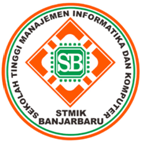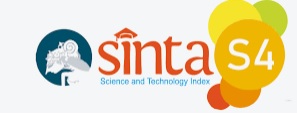Uji Klasifikasi Algoritma Naive Bayes Classification dalam Analisis Sentimen Ulasan Puncak B29 Lumajang
Abstract
B29 Peak is a tourist attraction which is located in Argosari Village, Senduro District, Lumajang Regency, which is the highest peak in the Bromo sand sea area with a height of 2,900 meters above sea level. Based on Google Maps, B29 Peak has the best review score for tourist attraction in Lumajang Regency, with an average score of 4.7 stars and reviewed by 3,368 users until October 25th, 2023. Sentiment amnalysis was carried out to group the very large number of user reviews as an evaluation in order to correct deficiencies and improve the quality of the tourist attraction. Grouping sentiment analysis is using the Naïve Bayes Classification. The result of classification obtained the average score of accuracy is 91.06%, precision 96.57%, recall 94.07% and F1-score 95.31%. While the best result is on the 150 data testing, with the accuracy of 92.67%, precision 97.20%, recall 95.21% and F1-score 96.19%.
Keyword: Sentimen Analisis; B29 Peak; Naïve Bayes Classification
Â
Abstrak
Puncak B29 merupakan salah satu objek wisata yang terletak di Desa Argosari, Kecamatan Senduro, Kabupaten Lumajang, yang merupakan puncak tertinggi di Kawasan lautan pasir Bromo dengan ketinggian 2.900 meter di atas permukaan laut. Berdasarkan situs Google Maps, Puncak B29 memiliki skor ulasan yang terbaik untuk tempat wisata Kabupaten Lumajang, dengan skor ulasan rata-rata 4,7 bintang dan diulas oleh 3.368 pengguna hingga 25 Oktober 2023. Sentimen analisis dilakukan untuk mengelompokkan ulasan pengguna yang jumlahnya sangat banyak sebagai evaluasi agar dapat memperbaiki kekurangan dan meningkatkan kualitas dari tempat wisata tersebut. Pengelompokkan sentimen analisis menggunakan algoritma Naïve Bayes Classification. Hasil klasifikasi diperoleh nilai rata-rata akurasi sebesar 91,06%, presisi 96,57%, recall 94,07% dan F1-score 95,31%. Sementara untuk perolehan hasil terbaik terdapat pada pengujian dataset sebanyak 150 data, dengan akurasi sebesar 92,67%, presisi 97,20%, recall 95,21% dan F1-score 96,19%.
Kata kunci: Sentimen Analisis; Puncak B29; Naïve Bayes Classification
Â
References
P. Arsi and R. Waluyo, “Analisis Sentimen Wacana Pemindahan Ibu Kota Indonesia Menggunakan Algoritma Support Vector Machine (SVM),†JTIIK (Jurnal Teknologi Informasi dan Ilmu Komputer), vol. 8, no. 1, pp. 147–156, 2021, doi: 10.25126/jtiik.202183944.
T. Hendrawati and C. P. Yanti, “Analysis of Twitter Users Sentiment against the Covid-19 Outbreak Using the Backpropagation Method with Adam Optimization,†Journal of Electrical, Electronics and Informatics, vol. 5, no. 1, pp. 1–4, 2021, doi: 10.24843/JEEI. 2021.v05.i01.p01.
O. Somantri and Dairoh, “Analisis Sentimen Penilaian Tempat Tujuan Wisata Kota Tegal Berbasis Text Mining,†JEPIN (Jurnal Edukasi dan Penelitian Informatika), vol. 5, no. 2, pp. 191–196, 2019, doi: 10.26418/jp.v5i2.32661.
A. Rifa, H. Sujaini, D. Prawira, and J. H. Hadari Nawawi, “Sentiment Analysis Objek Wisata Kalimantan Barat Pada Google Maps Menggunakan Metode Naive Bayes,†JEPIN (Jurnal Edukasi dan Penelitian Informatika), vol. 7, no. 3, pp. 400–407, 2021, doi: 10.26418/ jp.v7i3.48132.
S. Masturoh and A. B. Pohan, “Sentiment Analysis Against the Dana E-Wallet on Google Play Reviews Using The K-Nearest Neighbor Algorithm,†Pilar Nusa Mandiri Journal of Computing and Information System, vol. 17, no. 1, pp. 53–58, 2021, doi: 10.33480/ pilar.v17i1.2182.
N. T. Romadloni, I. Santoso, and S. Budilaksono, “Perbandingan Metode Naive Bayes, KNN Dan Decision Tree Terhadap Analisis Sentimen Transportasi KRL Commuter Line,†IKRA-ITH Informatika, vol. 3, no. 2, pp. 1–9, 2019.
N. Habibah, E. Budianita, M. Fikry, and I. Iskandar, “Analisis Sentimen Mengenai Penggunaan E-Wallet Pada Google Play Menggunakan Lexicon Based dan K-Nearest Neighbor,†JURIKOM (Jurnal Riset Komputer), vol. 10, no. 1, pp. 192–200, 2023, doi: 10.30865/jurikom.v10i1.5429.
S. Ulya, A. Ridwan, W. Cholid Wahyudin, and F. M. Hana, “Text Mining Sentimen Analisis Pengguna Aplikasi Marketplace Tokopedia Berdasar Rating dan Komentar Pada Google Play Store,†Jurnal Bisnis Digital dan Sistem Informasi, vol. 3, no. 2, pp. 33–40, 2022.
N. L. W. S. R. Ginantra, C. P. Yanti, G. D. Prasetya, I. B. G. Sarasvananda, and I. K. A. G. Wiguna, “Analisis Sentimen Ulasan Villa di Ubud Menggunakan Metode Naive Bayes, Decision Tree, dan K-NN,†Jurnal Nasional Pendidikan Teknik Informatika (JANAPATI), vol. 11, no. 3, pp. 205–215, Dec. 2022, doi: 10.23887/janapati.v11i3.49450.
M. Izunnahdi, G. Aburrahman, and A. E. Wardoyo, “Sentimen Analisis pada Data Ulasan Aplikasi KAI Access di Google Play Store menggunakan Metode Multinomial Naïve Bayes,†Jurnal Smart Teknologi, vol. 4, no. 2, pp. 192–198, 2023.
M. K. Anam, B. N. Pikir, and M. B. Firdaus, “Penerapan Na ̈ıve Bayes Classifier, K-Nearest Neighbor (KNN) dan Decision Tree untuk Menganalisis Sentimen pada Interaksi Netizen danPemeritah,†MATRIK : Jurnal Manajemen, Teknik Informatika dan Rekayasa Komputer, vol. 21, no. 1, pp. 139–150, Nov. 2021, doi: 10.30812/matrik.v21i1.1092.
I. K. A. G. Wiguna, P. Sugiartawan, I. G. I. Sudipa, and I. P. Y. Pratama, “Sentiment Analysis Using Backpropagation Method to Recognize the Public Opinion,†IJCCS (Indonesian Journal of Computing and Cybernetics Systems, vol. 16, no. 4, pp. 423–434, 2022, doi: 10.22146/ijccs.78664.
A. Rahman, Wiranto, and A. Doewes, “Online News Classification Using Multinomial Naive Bayes,†ITSMART: Jurnal Ilmiah Teknologi dan Informasi, vol. 6, no. 1, 2017.
B. U. Manalu, “Analisis Sentimen Pada Twitter Menggunakan Text Mining,†Teknologi Informasi Fak. ILKOM UNSUT, 2014.
D. N. Chandra, G. Indrawan, and I. N. Sukajaya, “Klasifikasi Berita Lokal Radar Malang Menggunakan Metode Naïve Bayes Dengan Fitur N-Gram,†Jurnal Ilmiah Teknologi Informasi Asia, vol. 10, no. 1, 2016.
Y. Pratama, K. Januar Miraswan, and S. Selatan, “Sentiment Analysis Using Pseudo Nearest Neighbor and TF-IDF Text Vectorizer,†Sriwijaya Journal of Informatic and Applications, vol. 4, no. 2, pp. 20–26, 2023.
B. Krithiga, P. Sabari, I. Jayasri, and I. Anjali, “Early detection of coronary heart disease by using naive bayes algorithm,†in Journal of Physics: Conference Series, 2021. doi: 10.1088/1742-6596/1717/1/012040.
D. D. Saputra, B. Pratama, Y. Akbar, and W. Gata, “Penerapan Text Mining untuk Assignment Complaint Handling Customer Terhadap Divisi Tterkait menggunakan Metode Decision Tree Algoritma C4.5 (Studi Case: PT. XL AXIATA, TBK),†Journal CKI On SPOT, vol. 11, no. 2, pp. 207–216, 2018.
How To Cite This :
Refbacks
- There are currently no refbacks.










